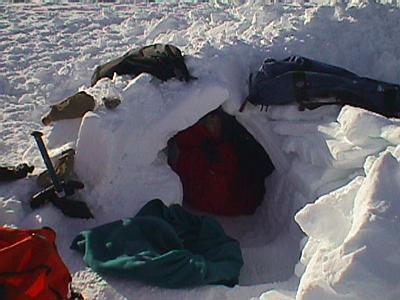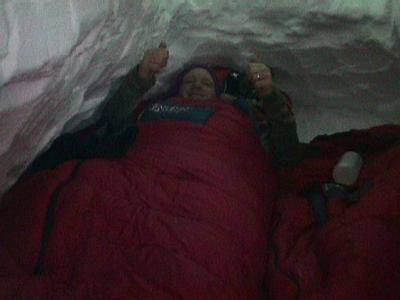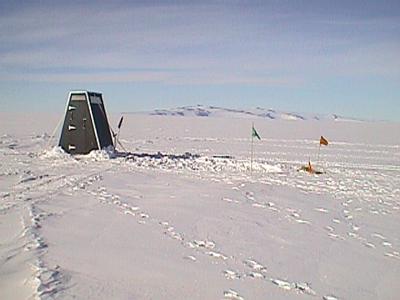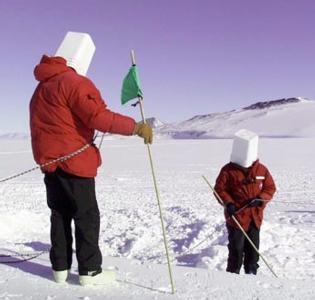23 October, 1999
A night on the Ross Ice Shelf! To think a mere 2 weeks ago I was in my nice,
warm bed in Wisconsin. Now I faced the prospect of sleeping in a hole in the
snow with the temperatures this Antarctic night falling to about -5F with
wind chills down to -30F. However, we were well prepared. Brennan and Bill,
our survival class instructors, had given us some very good advice. They
told us to make sure we drank plenty of liquids to make sure our body
remained hydrated. For the bodies' metabolism to run most efficiently and
produce the most heat, it needs plenty of water. Also, we needed to eat
plenty of food to provide the body with fuel. We had laid out our sleeping
bags in our shelter already. Under the bags were two, dense foam pads.
Inside the thick, Holofill bag was a fleece liner. When I got ready to get
in, I changed into some dry underwear and socks because my other pairs were
damp from sweating during the building of the shelters.
The shelter that Wojciech Majewski and I decided to construct was a
trench shelter. This is normally a one person shelter used when conditions
are very bad and you need a shelter quickly. You simply dig a grave-like
trench in the snow about 4 feet deep and long enough to accommodate a
person. Sounds easy, but Wojciech and I needed a two person trench, so we
had to move a lot of snow. Then we cut rectangular blocks of snow with a
snow saw. These needed to be long enough so two of them could be leaned
against each other to create a peaked roof over the shelter. We needed about
a dozen pieces, but the blocks kept breaking so we had to cut a lot more.
Once the roof was in place, we filled in the openings with chucks of snow
and covered the whole thing with loose snow. We then fashioned an entrance
and used the large duffels from our sleep kits to form the door. Our "Grave
That Saves" was completed.
I was ready to spend the night in cozy comfort. Well almost. Just
prior to crawling into my bag, I placed my plastic, quart water bottle in a
pot of boiling water. I then placed this bottle in my bag to warm it up a
bit. I also did a little exercise just before going to bed. Remember, the
sleeping bag doesn't provide heat, it only traps the heat your body
produces. The bag was quite cold when I slipped in. I pulled the hood of the
bag around my head so only my mouth and nose were exposed. I even covered my
eyes because it was very bright outside and the light came through the snow
into the shelter. I was set for the night. I must say, it did feel a bit
like I was in a crypt but I was warm. I stayed that way for most of the
night. Except for one problem. Remember all that liquid Brennan had told me
to drink? Well, you know what that means. In the middle of the Antarctic
night, I had to take a trip to the "yellow flag". Out on the ice, they place
a yellow flag away from the camp for people to use when they urinate. It is
very important that you only go there because snow is used as a source of
water, and you want to make sure you don't contaminate your water source.
There is a toilet at Snow Mound City for women.
After my trip to the "yellow flag", I did fall asleep most of the
night. My nose was quite cold and the breath froze on my bag. By the time
morning came, I was getting a bit chilled and I looked forward to moving
around and getting warm. Getting back into my wind pants, boots and parka
was quite a chore as they were pretty stiff and cold. But once I got out and
went for a walk, I was nice and warm again. We started up the stoves and
melted snow (not the yellow stuff) and frozen water for hot drinks and
oatmeal. I had a supply of water from the bottle I had in my bag.
About 9AM, Bill and Brennan picked us up in the Nodwell (They had
stayed in the instructors shack for the night - with heat!) and we headed
back to the instructors shack for a debriefing and hot drinks. Most everyone
got through the night in good shape. Several were quite cold and were very
happy to be done with this part of the training. The rest of the morning was
spent learning other survival skills such as radio operation and set up. We
finished up the course with a couple of survival role playing scenarios. In
one of them, we had to find a injured member of our team who was lost in
"white out conditions" somewhere outside the shack. White out conditions are
where the snow is blowing so hard that you cannot see more then a couple of
inches in front of your face. To simulate a "white out", we wore white
plastic pails over our heads. I will let you figure out how we accomplished
this task without anyone getting lost. All we had was a long piece of rope
and a lot of bamboo poles. Let me know how you would find the lost person.
I was quite tired after "Happy Camper School". However, after a
shower, a hot meal and a good (and warm) nights sleep, I look back on it as
a wonderful experience. Not only do I have more confidence in my abilities
to survive out in the cold, but I know I can help others if we are in a
survival situation. I hope I never have to use any of this knowledge in a
life-threatening situation, but I have the knowledge if I need it.
The day after survival school, it was back in the lab. We had a
backlog of samples and I helped John Simes process them. The drilling
project is going very well. They have drilled almost 350 meters of core.
They will stopping pretty soon to do some maintenance on the drill rig and
to run some tests on the rocks in the drill hole. Talk to you tomorrow.

Here I am in the "Grave That Saves".

Wojciech, a graduate student from Poland, crawling out of our shelter.

Inside the shelter, ready for a cozy night in Antarctica.

The facilities and the infamous "yellow flag" on the ice.

Survival class students during a "white out". This picture was provided by Josh Lucas of The Antarctic Sun (10/24/99)
Contact the TEA in the field at
.
If you cannot connect through your browser, copy the
TEA's e-mail address in the "To:" line of
your favorite e-mail package.
|
